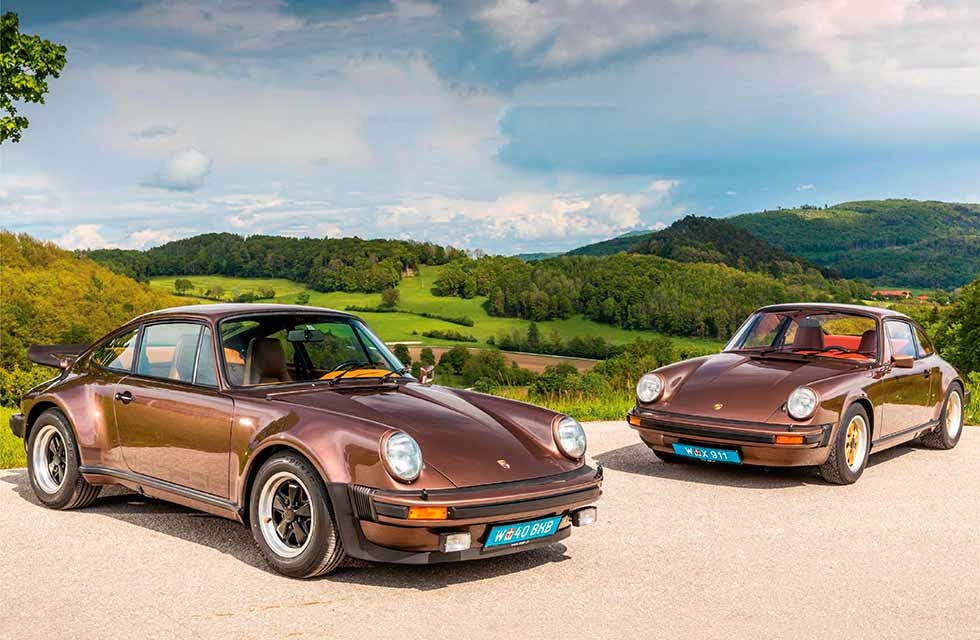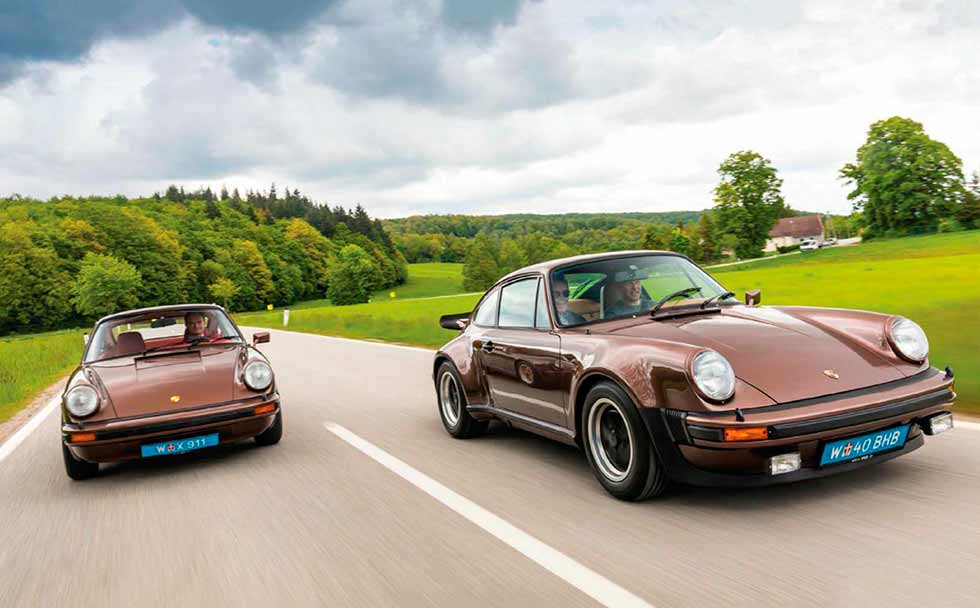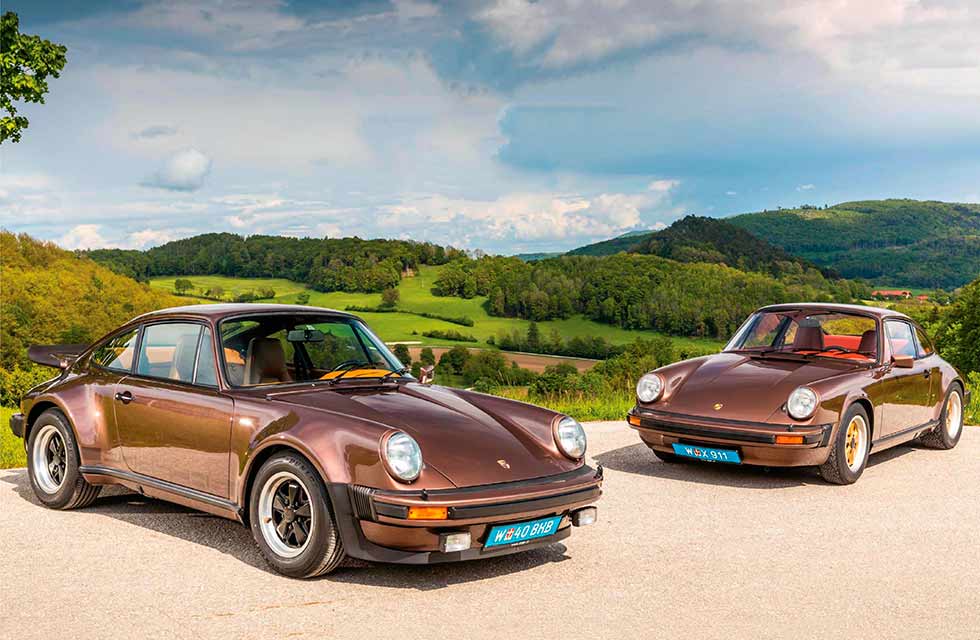
Tougher emissions and crash regulations in the 1970s could have killed the 911, but instead it flourished. Drive-My showcases both top-of-the-range offerings of the time… Written by Kyle Fortune. Photography by Daniel Pullen.
Turbo v Carrera: 930 3.0 v 2.7 Carrera
Relive the mid-1970s at Porsche when the company’s first supercar shared showrooms with its RS-engined stablemate.
After the swing of the 1960s, the 1970s are often lambasted, wrongly viewed as a decade of energy crises, political upheaval and scandal. The reality is that while the 1970s might have been a turbulent decade, they were also arguably a turning point in the modern world.

Those energy crises did raise global concerns over consumption and, unsurprisingly, the car was in the firing line, particularly in the US. Increasing legislation for fuel economy and emissions, as well as safety, demanded change. That created problems for Porsche with the 911. The 911s of 1970’s America would feature detuned engines to pass economy standards, EU and RoW cars largely escaping those, though those US regulations would have a pronounced impact on how the 911 would look.
“The 930 was a revelation, the word Turbo signifying big performance, and absolutely defining the following decade of the 1980s”
From 1973 onwards US domestic and imported cars had to survive a 5mph collision without any damage to the headlights, engine or safety equipment. The 911’s bumpers had to change, with the US regulation demanding innovation. The G-series bumpers were born, revolutionising the 911’s look and ensuring it would pass not just the 1973-onwards regulations, but also the later zero-damage standards that would come into force over the next decade.

Porsche evidentially thrives on the challenges posed by regulation, and those US rules forced the company’s hand changing the 911’s look. The styling department is credited as being responsible for those iconic bumpers, under then-director Anatole Lapine and a team consisting of Wolfgang Möbius, Dick Söderberg and Peter Reisinger.
In contrast to so many rivals’ hastily devised, somewhat awkward efforts, Porsche’s solution to the regulations was beautifully integrated and simply engineered. Larger, higher, body-painted bumpers with neoprene rubbing strips were adopted, to which functional ‘bellows’ which compressed on impact were fitted. The bellows were a neat solution which allowed the bumpers to move as much as 50mm, and were attached to collapsible steel tubes on European cars and hydraulic shock absorbers on US cars. The new bumpers were instrumental in the relocation of the battery, too, the now single battery being located in the luggage compartment in front of the left-hand front wheel, improving the weight distribution.
The rear would see a similarly styled wrap-around bumper hung off a complex aluminium extrusion, the lightweight metal adopted to keep additional mass at the rear to a minimum. Above the rear bumper Porsche adopted a reflective red band, joining the rear lights in with a styling element that’s largely pervaded the 911’s rear visual signature ever since.
“To drive, the MFI 2.7 Carrera is barely distinguishable from its celebrated RS relation”
The G-series was born, and despite rumours that perhaps the 911’s days were numbered, and talk of its replacement with the soon-to-be-launched 928, the changes would allow the 911 to flourish. Along with revisions to the 911’s styling came a range of new models in 1973, with the T, E, S and RS model line-up replaced by the 911, 911 S and Carrera models, all powered by Porsche’s 2.7-litre flat six with different power outputs: 150hp, 175hp and 210hp.
The flat six was derived from the 1973 RS’s 2.7-litre engine, and was coded 911/92 for the 911, 911/93 for the 911S and 911/83 for the Carrera. When it entered production in 1974 it retained the Nikasil barrels used on the RS before being replaced by a new material, Alusil. The 2.7 Carrera also retained Bosch mechanical fuel injection (MFI) and the 210hp output of the RS, which alone makes the 2.7 Carrera highly sought after. The other reason the 2.7 MFI is so prized is its relative rarity. Porsche only produced it briefly, it being replaced late in 1975 with the 3.0-litreengined Carrera.
Brief as the 2.7 Carrera’s light might have been, it shone brightly. The 2.7 MFI’s technical specification was largely that of the RS, but it does without the badging, status and hence price. It weighed much the same as a Touring-spec RS at 1,075kg and was built in similarly small numbers, with around 1,667 built. Its redline starts at 7,200rpm, that the same as the Rennsport’s. The power is the same, and the performance largely similar, with 62mph arriving around half a second slower than the 2.7 RS for a 6.3 second time, while the top speed is around 4mph slower at 148mph. Thank those regulations again for those slight reductions, the five-speed 915 transmission featuring slightly revised longer ratios in the 2.7 Carrera in a bid to improve emissions and economy.
Overall the G-series 911 was pivotal in the 911’s success, the changes it brought modernising and civilising the 911, and making it more appealing to a wider audience. The new bumpers added visual length to the 911, while deeper side sills with the jacking points coming through rather than sited below the panel also changed the 911’s look. As standard the 911 lost any exterior chrome trim, though it was available optionally, while in front of those now body-coloured headlight surrounds were headlight washers.
The Carrera 2.7 here typifies the model, its simple lines finished beautifully in Copper brown metallic paintwork. The 2.7 Carrera might have been something of a stopgap before the 3.0-litre’s introduction: a necessity of circumstance perhaps, but it is unquestionably a very special one. As Bernd Kahnau, nicknamed ‘der Elfer Macher’ – the man who made the 911 – said: “With the G model every year we made new things on the car.” The beautifully restored, original 2.7 Carrera here demonstrates that, it wearing the more delicate mirrors that would be replaced by the bulkier ‘flag’ mirrors from 1976.
Depending on the market the 2.7 Carrera came with the possibility of the RS’s ducktail spoiler, that changing to the option of the whaletail from 1975. Unadorned with the ducktail or the latterly available whaletail, the Carrera here does without the additional lip spoiler under the front to balance the aero effect of the optional rear spoiler.
If outwardly the Carrera brought a new style, then the interior too brought some welcome revisions to the 911 model. As with the exterior, many of these were related to safety, all models now coming with seats with integral head restraints to help prevent whiplash in an accident, the driver and passenger held in by standard inertia-real seatbelts from the manufacturer Repa. The dashboard gained some additional vents to aid side window demisting, while the entire heating system was improved, too.
Like the exterior, chrome trim was largely removed, while the door trims gained lidded compartments for oddment storage. The loss of chrome inside immediately modernised the 911’s interior. So too did the large, simple iconography on the soft knob controls, the Copper red leather of the 2.7 Carrera here beautifully contrasting with the Copper brown metallic paintwork outside. A smaller 380mm sized steering wheel featured in the Carrera, replacing the 400mm wheel of the standard 911 and 911S. It was connected to a front axle on the Carrera which had a thicker – and RS rivalling – 20mm antiroll bar over the 911 and 911S and a rear anti-roll bar of 18mm thickness. Braking for the Carrera was largely carried over from the previous S model, using an S-type aluminium caliper.
More significantly, aluminium would feature in the G-series’ suspension, the rear semi-trailing arms now constructed in forged aluminium. These were significantly stiffer, yet around 3.5 kg lighter than the steel ones used previously. A larger wheel bearing was also fitted.
To drive, the MFI 2.7 Carrera is barely distinguishable from its celebrated RS relation, though without the Rennsport’s more purposeful, arguably compromised specification – with the MFI having some sound deadening, and even more from 1974, it’s a more civilised daily proposition. It gained on servicing intervals, too, the G’s larger oil tank allowing this, though the 2.7’s reign as the top-performing model in the 911 range would be short-lived with Porsche adding a model above it – and its 3.0-litre replacement – that would add a new word to the lexicon of not just Porsche, but car enthusiasts globally: Turbo.
Porsche had experimented with forced induction for years before the production Turbo was revealed. Its 917-10s had dominated in the wild CanAm race series, while the turbocharged racing 911s demonstrated the technology all over the world. Like the RS models, the Turbo was in fact a model that was required to homologate Porsche’s racing activities. The plan was originally expected to be to build 400 to satisfy FIA homologation regulations for Group 4 competition, with the Turbo initially expected to be built in the same, uncompromising specification as the 1973 RS. Luxury won out, however, the Turbo becoming a top-of-the-line model with a sizeable price tag to match.
First shown as a concept in 1973 at the Frankfurt Auto Show wearing RSR-style bumpers and the signature rear wing, a decal strip running from the front wings and the tantalisingly scripted ‘Turbo’ aft of the rear wheels left no doubt of Porsche’s new model’s induction for the 3.0-litre flat six engine. The production model wouldn’t be shown until the 1974 Paris Motor Show as the 911 Turbo, or Turbo Carrera in the US. The car here is number 55 of the first year’s 274 production run. Recently fully restored to its immaculate original, condition by Mash Motor, it is finished in the same period-correct Copper brown metallic of the 2.7 MFI next to it, only with the interior fully trimmed in brown beige leather.
Porsche’s decision to launch such a potent, range-topping sports car in the middle of a decade where the worst post-war economic conditions were being felt was bold. Porsche’s director Heinz Branitzky was confident, saying: “If we’re not capable of selling such a superb product as this, then it’s time for us to stop building sports cars altogether.”
Even so, early owners in its home market would be unable to test the Turbo’s prodigious top speed, as Germany had temporarily imposed 100km/h (62mph) speed limits on its famously unrestricted Autobahns in a bid to help save fuel during the OPEC oil crisis. Sunday driving at the time was also banned, but despite this the Turbo would go on to be a commercial success – 1,000 being built by May 1976 and 2,850 of the early 3.0-litre Turbos being built over the first three years of production underlined the confidence the company had in its flagship product.
Much of the driving force behind the Turbo came from engineer Ernst Fuhrmann, saying: “I was of the opinion that racing must have a connection to the normal automobile.” What Porsche produced was nothing like an ordinary automobile, though. The Turbo was a revelation, the word Turbo signifying big performance, and absolutely defining the following decade of the 1980s. The Turbo’s specification borrowed from Porsche’s racers, the hubs being 917-derived, the brakes too, while the front and rear suspension was largely borrowed from the 3.0 RSR.
The type 930/50 engine was 3.0 litres in capacity, it fitted with a KKK 3LDZ exhaust-driven turbo producing 0.8 bar of boost that allowed the Turbo its output of 260hp and 350Nm of torque at 4,000rpm, mated to a four-speed gearbox. That would give the Turbo a 0-62mph time of 5.4 seconds and top speed in excess of 250km/h (155mph). The 3.0-litre engine featured Nikasil barrels and forged-alloy pistons in an aluminium crankcase, with oil squirters underneath to cool the pistons.
Just as significant as its then-outrageous performance was its looks, with the Turbo’s flared front and rear wheel arches and whaletail – changing to the tea-tray from 1978 onwards – rear spoiler, which covered wider seven-inch front and eight-inch rear tyres fitted to a wider track on both axles. The luxury specification included headlight washers, a rear wiper, an electric sunroof and windows, tinted glass and climate control. The rev counter read to 7,000rpm, its redline at 6,600rpm.
Unsurprisingly the Turbo was extremely well received in the motoring press, it winning praise in every test, though it was also noted that it needed a skilled driver to extract the very best from it. Despite Porsche’s best efforts the turbo lag could catch you out, with boost arriving relatively suddenly. That became part of the Turbo legend, however, making early, original cars such as this example highly prized and sought after.
A significant car not just because it was Porsche’s first Turbo road car, but was among the very first production turbocharged cars, it’s gone on to become its own icon in the 911 range, defining the era within which it was created and a signature for the highest performance ever since. It would change incrementally over the next 14 years, but an early example like this, excellently restored to one of the most convincing standards we’ve seen, is arguably the jewel in the crown.
Which to choose? It depends what you’re after from your classic 911. If it’s luxury and power, look no further than the Turbo. The Carrera satisfies a need for pin-sharp performance. Regardless, the 1970s weren’t so bad after all. With greater regulation came Porsche’s typical approach of innovation. If history is a signal of things to come, then ever-tightening rules isn’t something we should be afraid of.
ABOVE These Copper brown beauties defined the era at Porsche. It was the Turbo which lead the way with sales despite costing more than the average home, though the 2.7 Carrera – viewed as a ’70s GT3 Touring – is just as adored today. TOP Turbo’s interior has been given sympathetic restoration, retaining the original carpet. Copper red 2.7 Carrera interior has also been overhauled, including renewed pasha centres. BELOW The flat six was bored out to 95mm for the Turbo’s 3.0-litre displacement, with Bosch K-Jetronic fuel injection used. The 2.7 Carrera retained mechanical fuel injection carried over from the ’73 RS. BOTTOM Both cars had a 300kph VDO speedo, but how they attempted to get there was very different, the Turbo’s redline just before 7k, the Carrera’s just after. BELOW The Turbo’s whaletail was replaced by a tea tray profile for intercooled cars from 1977. Carreras, meanwhile, came with a ducktail or, later, a whaletail, though some as here were optioned as a ‘flat back’.
THANKS The 930 3.0 in our pictures is for sale at Mash Motor. For more information on its stellar restoration visit mashmotorltd.com. The 2.7 Carrera in our pictures was supplied by Dr Georg Konradsheim. For more information visit rsr.at
930 Turbo
Year 1975
Engine
Capacity 2,994
Compression ratio 6:5.1
Maximum power 260hp @ 5,500rpm
Maximum torque 350Nm @ 4,000rpm
Transmission Four-speed manual
Suspension
Front Independent; MacPherson struts; torsion bars; telescopic dampers and anti roll bar
Rear Independent; semi-trailing arms; torsion bars; telescopic dampers; anti-roll bar
Wheels & tyres 7×15-inch; 215/60/VR15 Rear 8×15-inch; 225/50/VR15
Dimensions
Length 4,291mm
Width 1,775mm
Weight 1,140kg
Performance
0-62mph 5.4 seconds
Top speed 155mph
2.7 Carrera MFI Model
Year 1974
Engine
Capacity 2,687
Compression ratio 8:5.1
Maximum power 210hp @ 6,300rpm
Maximum torque 255Nm @ 5,100rpm
Transmission Five-speed manual
Suspension
Front Independent; MacPherson struts; torsion bars; telescopic dampers and anti roll bar
Rear Independent; semi-trailing arms; torsion bars; telescopic dampers; anti-roll bar
Wheels & tyres 6×15-inch; 185/70/VR15 Front 7×15-inch; 205/55/VR15
Dimensions
Length 4,291mm
Width 1,652mm
Weight 1,075kg
Performance
0-62mph 6.3 seconds
Top speed 148mph






